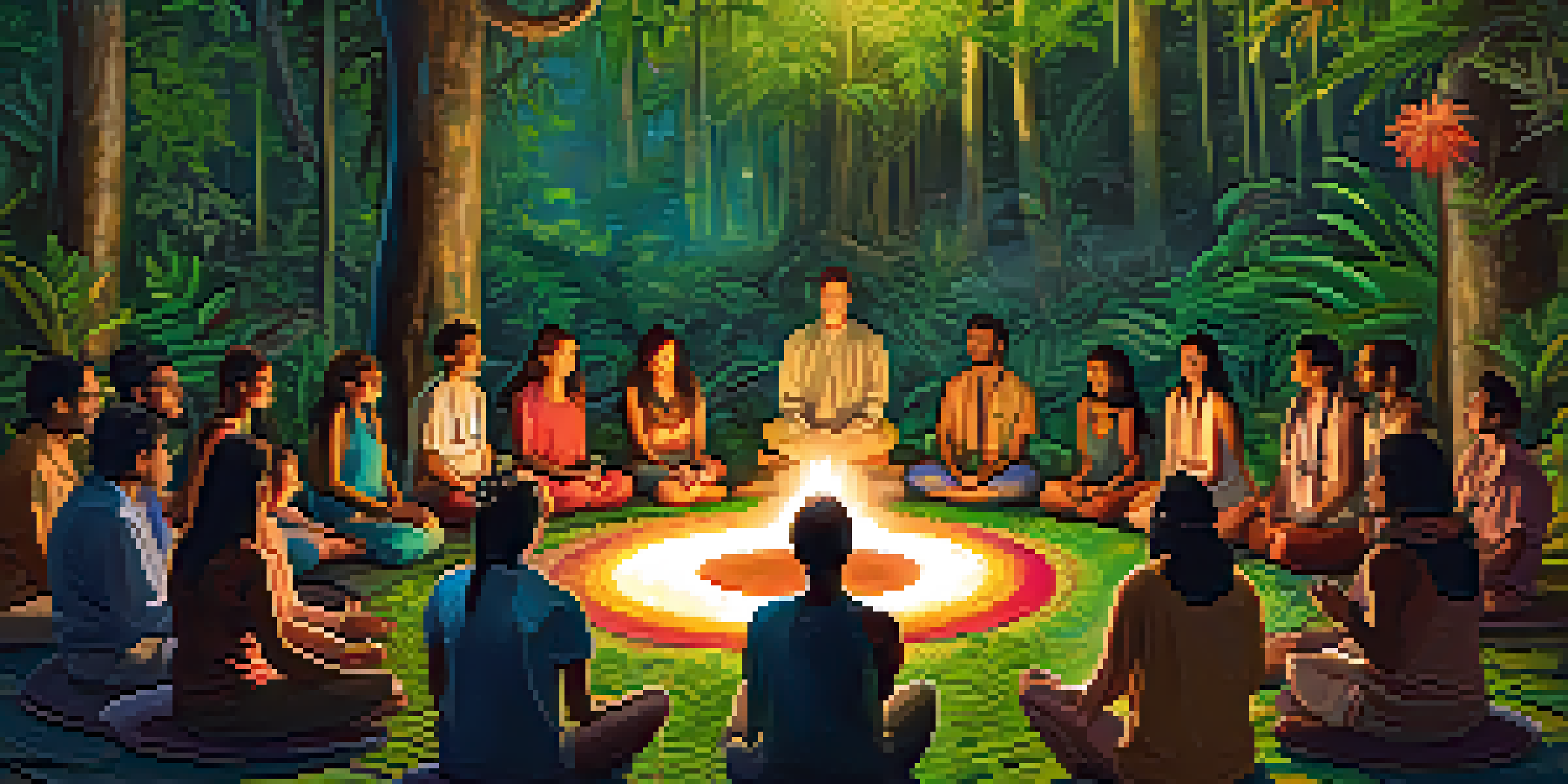Exploring the Role of Set and Setting in Ayahuasca Experiences

Understanding Set and Setting in Ayahuasca Use
Set and setting are crucial concepts in the context of ayahuasca experiences. 'Set' refers to an individual's mindset, including their thoughts, emotions, and expectations going into the ceremony. Meanwhile, 'setting' encompasses the physical and social environment where the experience takes place, such as the location and the presence of facilitators or guides.
The mind is everything. What you think you become.
The interplay between set and setting can significantly influence the quality and outcomes of an ayahuasca journey. A positive mindset combined with a safe, supportive environment tends to foster healing and insightful experiences. Conversely, a negative mindset or an uncomfortable setting can lead to challenging experiences that might not be beneficial.
Understanding these concepts is essential for anyone considering an ayahuasca ceremony, as they underscore the importance of preparation and environment. By paying attention to both set and setting, participants can enhance their likelihood of having a transformative journey.
The Impact of Set: Mindset Matters
The mindset of an individual, or 'set', plays a pivotal role in shaping their ayahuasca experience. Participants often enter the ceremony with specific intentions, fears, or hopes. A clear and positive intention can guide the journey, helping individuals navigate the often intense emotions and visions that arise.

For instance, someone who approaches the ceremony with a desire for healing may find that their experience is filled with insights related to their emotional or physical ailments. On the other hand, if a participant carries anxiety or skepticism, they might struggle to connect with the medicine, potentially leading to a more difficult experience.
Set and Setting Shape Experiences
The mindset ('set') and environment ('setting') are crucial factors that significantly influence the quality and outcomes of an ayahuasca journey.
Therefore, cultivating a supportive mindset—through practices like meditation, journaling, or counseling—can significantly enhance the quality of the experience. By setting the right mental stage, participants can open themselves up to deeper reflections and healing.
The Role of Setting: Environment Matters
The setting of an ayahuasca ceremony can dramatically influence the overall experience. A serene, natural environment, such as a jungle or a quiet retreat center, can enhance feelings of safety and connection to nature. In contrast, a chaotic or uncomfortable environment might lead to distractions and fear, detracting from the potential benefits of the journey.
The environment is the invisible hand that shapes our behavior.
Moreover, the presence of experienced facilitators can create a supportive atmosphere that encourages trust and openness. These guides often have a wealth of knowledge about the process and can help participants navigate challenging moments, providing reassurance and guidance when needed.
Ultimately, a well-thought-out setting that promotes comfort and safety is essential for fostering positive experiences. This underscores the necessity for participants to choose their ceremonies carefully, considering both location and the qualifications of the facilitators.
Creating a Supportive Environment
Creating a supportive environment involves thoughtful planning and consideration of various elements. This includes choosing a location that feels safe and inviting, as well as ensuring that the physical space is conducive to relaxation and introspection. Soft lighting, comfortable seating, and access to nature can all enhance the setting.
Additionally, the social dynamics of the group participating in the ceremony can influence individual experiences. A small, intimate group can foster deeper connections and shared understanding, while a larger group may lead to feelings of overwhelm for some individuals.
Preparation Enhances Outcomes
Engaging in mental and practical preparation before the ceremony can greatly improve the chances of a transformative experience.
In essence, the goal is to create a space where participants feel held and understood, allowing them to dive deeper into their journey. As a result, the setting becomes a nurturing cradle for transformative experiences.
The Importance of Preparation
Preparation is a key factor in maximizing the benefits of an ayahuasca experience. This includes not only mental preparation, such as setting intentions, but also practical considerations regarding the setting. Participants should familiarize themselves with the location and the facilitators, ensuring they feel comfortable and safe.
Moreover, engaging in practices like diet changes, meditation, or even personal reflection prior to the ceremony can enhance the overall experience. These preparatory steps help align the mind and body, allowing participants to approach the ceremony with a clearer perspective.
Ultimately, preparation helps individuals build a solid foundation for their journey. By taking the time to prepare, participants can significantly improve their chances of having a meaningful and transformative experience.
Navigating Challenging Experiences
Even in optimal conditions, ayahuasca experiences can sometimes be challenging. Individuals may encounter difficult emotions or unsettling visions during their journey. Understanding the role of set and setting can provide valuable tools for navigating these moments, helping participants feel more equipped to face discomfort.
For example, if a participant recognizes that their challenging experience stems from an anxious mindset or an uncomfortable setting, they can work to reframe their thoughts or focus on grounding techniques. This awareness can empower them to shift their experience from one of fear to one of growth.
Integration is Key Post-Ceremony
Creating a supportive environment for reflection after the ceremony is essential for effectively processing and integrating the insights gained.
Support from facilitators and fellow participants can also be crucial during these moments. Having a network of understanding individuals can provide reassurance, reminding participants that they are not alone in their journey, even when facing difficulties.
Integrating Insights Post-Ceremony
After the ceremony, the process of integration becomes vital. Participants often leave with profound insights and experiences that require time and reflection to fully understand. This is where the concepts of set and setting continue to play a role, as the environment post-ceremony can influence how individuals process their experiences.
Creating a calm and supportive space at home, where one can reflect on their journey, is essential. Engaging in practices such as journaling, talking with trusted friends, or seeking guidance from therapists can aid in the integration process, allowing participants to make sense of their experiences.

Ultimately, integration is about translating the insights gained during the ayahuasca experience into actionable steps for personal growth. By fostering a nurturing environment and a supportive network, individuals can better assimilate their experiences, paving the way for continued healing and transformation.